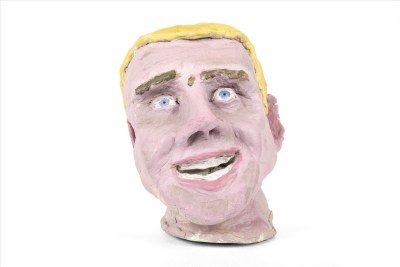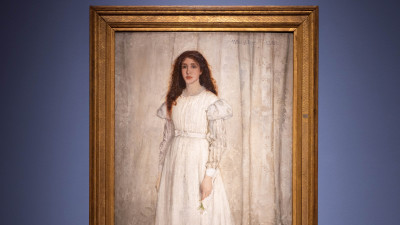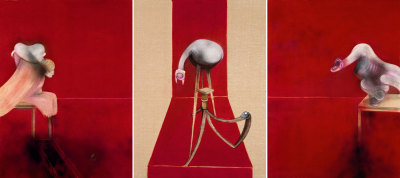10 inspirational women in the arts
10 inspirational women in the arts
By Asha McLoughlin, Kira Milmo, Sara Sassanelli, Harriet Baker and Louise Cohen
Published 1 March 2016
To mark International Women’s Day, we asked some of the great women in the UK art world, from artists to editors, where things stand when it comes to equality. Here’s what they said.
-
Women in the British art world are in a better position than ever before. They’re increasingly holding top roles in the sector and arts organisations are working towards a better gender balance. Frances Morris was recently made Tate Modern’s first female director, and their galleries devoted three major 2015 shows to female artists – while here at the RA, eight out of ten Royal Academicians elected last year were women, from the architect Farshid Moussavi to the painter Vanessa Jackson. Our Schools admit equal numbers of male and female students – and in fact, art schools across the country are commonly now populated by more female students than male.
That’s the rosy side; none of it untrue or insignificant. Here comes the rest: when the East London Fawcett Group audited 134 commercial London galleries in 2013, they found that only 31 percent of the represented artists were women. Of 29 public institutions in London, nearly a third presented no female solo shows. Continuing inequality is reflected in auction prices too. Modigliani’s Reclining Nude holds the auction world record at £113 million; the female record is £28.8 million, for Georgia O’Keeffe’s Jimson Weed, White Flower No. 1.
We spoke to some of the women leading the way in closing that gap. They are ten among many, of course; what follows isn’t a ranking but a platform for the voices of some exemplary figures. We asked how they see the landscape in 2016, what advice they’d give to aspiring women and what, if anything, should be done to promote equality.
-
Treat it as a level playing field and it will be.
Cornelia Parker RA
-
Sculptor
Cornelia Parker RA
Finding herself in an all-female Turner Prize shortlist in 1997, Cornelia Parker was often assumed to be a feminist artist in her early career. But the “ferocity”, she says, of work like Cold Dark Matter – for which she blew up a shed and suspended its exploded pieces back together – was never about gender.Parker says she was “brought up as a surrogate son” by her father. By the time she was studying sculpture at Wolverhampton Poly in the 70s, she barely noticed that she was in the minority. “It was a very political issue at the time, but I sort of side-stepped it. Not because I wasn’t a feminist but because I assumed I had the same rights as a boy. Gender was never a central plank in my thinking.”
Today, Parker – soon to unveil a roof installation at New York’s Met, following prominent commissions, including a giant replica clock at St. Pancras International – suggests women should have the same confidence: “It should be a level playing field. I’m sure it’s not, but just treat it as it is and it will be. That’s my philosophy.”
-

Cornelia Parker RA, One More Time, 2015.
Photo: Sam Lane.
-
Photographer
Gillian Wearing RA
That same all-female Turner Prize shortlist of 1997 was won by Wearing, who studied at Chelsea College of Art and Goldsmiths College. She had previously worked as a secretary. “I went from a job that was deemed female-orientated to art school, which was equal men and women. It was the first time I didn’t think of myself in terms of gender and occupation.”Wearing recently made headlines for A Real Birmingham Family, a life-size bronze of two local sisters – both single mums – with their two children, unveiled outside Birmingham’s public library. But she is best known for her use of photography and video, often using masks – both male and female – to explore identity and the gulf between public personas and private lives. In such works she has inhabited characters including her brother and sister, and Diane Arbus and Robert Mapplethorpe, to name a few.
-
I use a different type of performance to be a man rather than a woman... The further you get away from your own identity, the more liberating it is.
Gillian Wearing RA
-
Aside from the discomfort of the heavier – “painful” – male masks, the artist likes wearing these the most: “I think if you look carefully at the eyes you can see they are female, but the masks have a very strong presence. Of course, I use a different type of performance to be a man rather than a woman… The further you get away from your own identity, the more liberating it is.”
But “male” or “female” doesn’t begin to describe what Wearing is interested in exploring. “Identity comes from nature, nurture, chance, fate, experience, gender, age… the list is endless. We are too complex for it to be one item on the list.”
-

Gillian Wearing RA, Me As Mapplethorpe, 2009.
(based upon the Robert Mapplethorpe work: Self Portrait, 1988. © Robert Mapplethorpe Foundation).
Framed bromide print. © the artist, courtesy Maureen Paley, London.
-
Painter
Rose Wylie RA
After studying at Goldsmiths, where she met her husband, Rose Wylie returned to painting in the 1980s after raising a family. Aged 82, she is now regarded by many as one of Britain’s most exciting contemporary painters.“I married early and had children, and so I didn’t paint for a long time,” she explains. “But that wasn’t necessarily a bad thing. I’d been through a lot, and thought a lot, and I came back to my work afresh.” Her fearlessness is being recognised. In 2014, Wylie scooped the John Moores Painting Prize; last year she was elected a Royal Academician, and she currently has her first major solo show at Margate’s Turner Contemporary.
-
I like to be called a painter, not a woman painter. Those are my politics.
Rose Wylie RA
-
How does she feel about being a “woman artist”? “I’m not keen on being labelled,” she says. “I like to be called a painter, not a woman painter… I’m simply a visual painter.”
Self-sufficiency is the quality Wylie would like to bestow on today’s young artists. "I grew up the seventh child in my family, and I learned not to expect anything. That would be my advice – it was the best training. I made my own arrangements, and I still do.”
-

Rose Wylie RA in her Kent studio
Photograph by Anna Huix
-
Architect
Catherine Pease
“There’s a real problem with architecture,” says Catherine Pease. “The whole industry needs to change. There are so many women contributing to architecture who are not being recognised.”In 2009, Pease founded vPPR, the only architectural firm in the UK with three female directors, with university friends Tatiana von Preussen and Jessica Reynolds. Pease says there were raised eyebrows at first – but the trio has indisputably impressed the industry. Last year, they won both Emerging Woman Architect of the Year and a RIBA award for an airy vaulted house in Shepherd’s Bush.
It was a reaction to an inflexible, male-heavy industry. “There’s a high drop-out rate,” she says. “The older you become as an architect, the fewer women there are around you because of inflexible hours and bad maternity pay. It’s a lost opportunity for architecture.”
Their practice is not without struggle either – “as an all-female practice you feel as if everyone’s looking at you” – but it makes vPPR all the more determined. “We’re supporting women. We want to prove that what we do as a practice is possible for the industry as a whole. There are some great female architects out there, and we need to encourage them.”
-
I want to look beyond the canon, to challenge the accepted narrative of art history.
Iwona Blazwick
-
Gallery director
Iwona Blazwick
Having overseen a major expansion of the Whitechapel in 2009, Blazwick, its director of 15 years, reopened it with three female monograph shows; Elizabeth Peyton, Sophie Calle and Alice Neel. The press noted that fact – one which, Blazwick says, would have been of no interest had it been shows on male artists.Blazwick is proud of the Whitechapel’s promotion of female artists. Every two years the gallery hosts the Max Mara Art Prize for Women , the only visual art prize for women in the UK: “It’s a very exciting time to be an emerging female artist in the contemporary art world, and we’re at the heart of that.”
But despite “opportunities unfolding exponentially” for women, there is still huge disparity in representation and recognition. Where the Whitechapel leads, Blazwick is keen for the rest of the art world to follow. “Museum directors and collectors need to be more courageous in providing a platform for female artists,” she explains. “They need to display creativity by women to women in their audience. Women are still outnumbered, and there is much to be done.”
-

vPPR's Jessica Reynolds, Catherine Pease and Tatiana von Preussen

Iwona Blazwick

Ann Dumas at Monet's garden in Giverny

Charlotte Mullins
-
Editor
Charlotte Mullins
An art historian, author, editor and broadcaster, Mullins’ CV includes editing Art Review, monographs on artists such as Rachel Whiteread and regular appearances on BBC arts programmes like Front Row and Saturday Review. None of it has felt judged by her gender, she says – but that doesn’t mean gender hasn’t been a factor.“Perhaps the traits that have hindered me at times – a lack of confidence, a belief others are doing or could do things better, guilt and conflict of interest – are areas that are most commonly seen in women.” In contrast, during years editing magazines, Mullins noted an “audacity and a devil-may-care attitude in some men”, that often led to a male-heavy mix. “Male writers would take on articles, then some would call and say it was going to be late – or they wouldn’t file at all, or it would be sub-standard. I rarely encountered this from women: they wouldn’t take on articles, citing over-work or not being right for the job.”
Her advice? “Society is built on male values, so I feel as a woman you have to play to male strengths – become ballsy, audacious, in the moment – and any crisis of confidence will be unsupported.” Additionally, Mullins would like to see some “grassroots work” – to “help the world slowly change to see women’s strengths as just that, strengths.”
-
There’s a lingering feeling that art history is a soft option for girls.
Ann Dumas
-
Curator
Ann Dumas
Dumas joined the RA following years as a research fellow at New York’s Guggenheim, and is the curatorial powerhouse behind some of our most loved shows; The Real Van Gogh: the Artist and his Letters, Degas and the Ballet – and our current blockbuster, Painting the Modern Garden: Monet to Matisse.Dumas found herself in a classroom of mostly women when she studied art history at university – a stereotype that remains a problem, she says. “There’s an assumption that art history is for people, particularly women, with privileged backgrounds, because it’s not a career like engineering or medicine. And with that come lower aspirations for pay and position. Women are held back.”
The museum world, in contrast, is a “male-dominated hierarchy”, she says. “Most of the museum directors in London are men. Frances Morris, who’s just been appointed Tate Modern’s director, is rather unusual. I admire her very much.” What should be done? “At university level, art history needs to be treated as a serious academic career, with women on an equal footing to men.”
-
Educator
Eileen Cooper RA
The first elected female Keeper of the RA Schools, artist Eileen Cooper is a passionate and experienced teacher, highly regarded for her strongly figurative work. “As an artist who works from a female perspective… I have had success as a career artist and been elected a Royal Academician so there is respect for what I do – but in the 80s you did hear some comments from curators that it’s ‘women’s work.’ That hasn’t been said recently,” she says.
-
Women are still under-represented. It’s absolutely shocking. I’ve made my views on that quite clear.
Eileen Cooper RA
-
Cooper feels that women of her generation are angry about the way they felt they were treated at art school, a lack of opportunity and “the way work was perceived by male curators, gallerists, art school teachers, critics.” Art schools were at least among the first in the sector to promote equality, though – something that happily today is fundamental to the RA Schools. But the same agenda has not been applied to the gallery system. “Things have been very slow to change… women are still under-represented. It’s absolutely shocking. I’ve made my views on that quite clear.”
Having a family in her early career meant choosing “not to pursue certain things”, Cooper admits – a show of her work in the USA she didn’t attend, for example. “I didn’t go as I had two babies. I should have probably gone.”
Cooper’s advice to young women today? “I want women to be confident, to seize the opportunities they are presented with and to be ambitious. Feel that it’s ok to make work from a female point of view if that’s what they want to do. If they don’t feel their work is gendered that’s fine as well.”
-

Eileen Cooper RA in her studio
Photo: © Eamonn McCabe
-
Graduate
Rebecca Ackroyd
Ackroyd graduated from the RA Schools last year, her final year show featuring larger than life sculptures of legs in chicken wire and bandages – crotches at head height.“For a long time I tried to make work that was genderless. I think actually the more I make work, the more violent and more directly feminine it becomes,” she says. “I’m just allowing my personality to come through. When women make certain decisions in their work it gets labelled as self-obsessed or aggressive.”
-
Sexism needs to be challenged. This attitude that discounts women for not featuring in art history... it's getting a bit stale.
Rebecca Ackroyd
-
Still, as a young female artist Ackroyd says her own experience of the art world has been largely positive so far – but feels strongly that more needs to be done by institutions. “There seems to be a much bigger presence of women currently, but I think institutions like the RA should do more to ensure that there’s equal representation of women in their programmes.”
There’s also a tendency to fall back on historical prejudice, she says. “Sexism needs to be challenged. This attitude that discounts women for not featuring in art history, so ‘why should we show them now?’ – it’s getting a bit stale. It’s a pathetic excuse.”
-

Rebecca Ackroyd
Photo: Gabby Laurent
-
Collector
Valeria Napoleone
This patron and collector exclusively supports women artists, since purchasing her first piece in 1997. “It was not a strategy,” Napoleone explains. “It was a natural decision dictated by my fascination and excitement at that time for women artists like Cindy Sherman and Barbara Kruger.”
-
Greatness and talent should not be ignored. It is a loss for us all, not just for women.
Valeria Napoleone
-
Of course, she adds, being aware of the underrepresentation of women in public and commercial galleries played a key role too. With that in mind, she launched Valeria Napoleone XX, a project aimed at “increasing the visibility of great women artists’ works and their practice.” The scheme places early- to mid-career work by female artists in museums across the US and UK.
Is gender an important aspect of Napoleone’s own career? “I am driven not by the fact that I am a woman, but by the excitement of so much untapped potential in this world paired with a strong sense of justice. Greatness and talent should not be ignored: it is a loss for us all, not just for women.”
-

Valeria Napoleone
-
What do you think?
Do women have equal standing in the art world? Is this conversation still relevant? What more should be done? Share your experience below, or on social media:
Twitter @royalacademy
Facebook /royalacademy
Instagram @royalacademyarts
International Women’s Day is on Tuesday 8 March. #IWD2016 #PledgeforParity













